Howard University
Howard University is a private, federally chartered historically black research university in Washington, D.C., located in the Shaw neighborhood.[6] It is classified among "R2: Doctoral Universities – High research activity" and accredited by the Middle States Commission on Higher Education.[7]
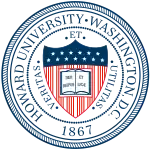 | |
| Motto | Veritas et Utilitas |
|---|---|
Motto in English | "Truth and Service" |
| Type | Private federally chartered historically black research university |
| Established | March 2, 1867 |
| Accreditation | MSCHE |
Academic affiliations | |
| Endowment | $865.3 million (2023)[1] |
| President | Ben Vinson III |
| Provost | Anthony Wutoh[2] |
| Students | 12,065 (Fall 2021)[3] |
| Undergraduates | 8,964 (Fall 2021)[3] |
| Postgraduates | 3,101 (Fall 2021)[3] |
| Location | , , United States 38°55′20″N 77°01′10″W |
| Campus | Large City,[4] 300 acres (1.2 km2) |
| Newspaper | The Hilltop |
| Colors | Blue Red Gray[5] |
| Nickname | Howard Bison and Lady Bison |
Sporting affiliations | |
| Mascot | Bison |
| Website | www |
 | |
Established in 1867, Howard is a nonsectarian institution. It offers undergraduate, graduate and professional degrees in more than 120 programs.
History
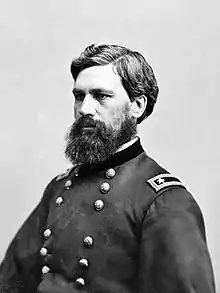

19th century
Shortly after the end of the American Civil War, members of the First Congregational Society of Washington considered establishing a theological seminary for the education of black clergymen. Within a few weeks, the project expanded to include a provision for establishing a university. Within two years, the university consisted of the colleges of liberal arts and medicine. The new institution was named for General Oliver Otis Howard, a Civil War hero who was both the founder of the university and, at the time, commissioner of the Freedmen's Bureau. Howard later served as president of the university from 1869 to 1874.[8][9]
The U.S. Congress chartered Howard on March 2, 1867, and much of its early funding came from endowment, private benefaction and tuition. (In the 20th and 21st centuries, an annual congressional appropriation, administered by the U.S. Department of Education, funds Howard University and Howard University Hospital.)[10]
Many improvements were made on campus. Howard Hall was renovated and made a dormitory for women.[11]
20th century
From 1926 to 1960, preacher Mordecai Wyatt Johnson was Howard University's first African-American president.[12]
The Great Depression years of the 1930s brought hardship to campus. Despite appeals from Eleanor Roosevelt, Howard saw its budget cut below Hoover administration levels during the presidency of Franklin D. Roosevelt.[13]
In the 1930s, Howard University still had segregated student housing.[14][15]
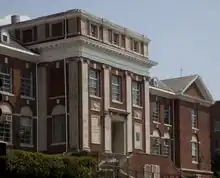
Howard University played an important role in the Civil Rights Movement on a number of occasions. Alain Locke, chair of the Department of Philosophy and first African American Rhodes Scholar, authored The New Negro (1925), which helped to usher in the Harlem Renaissance.[16] Ralph Bunche, the first Nobel Peace Prize winner of African descent, served as chair of the Department of Political Science.[17] Beginning in 1942, Howard University students pioneered the "stool-sitting" technique of occupying stools at a local cafeteria which denied service to African Americans, blocking other customers waiting for service.[18] This tactic was to play a prominent role in the later Civil Rights Movement. By January 1943, students had begun to organize regular sit-ins and pickets around Washington, D.C. at cigar stores and cafeterias which refused to serve them because of their race. These protests continued until the fall of 1944.[19]
Stokely Carmichael, also known as Kwame Toure, a student in the Department of Philosophy and the Howard University School of Divinity, coined the term "Black Power" and worked in Lowndes County, Alabama as a voting rights activist.[20] Historian Rayford Logan served as chair of the Department of History.[21] E. Franklin Frazier served as chair of the Department of Sociology.[22] Sterling Allen Brown served as chair of the Department of English.
| 1867 | Charles B. Boynton |
| 1867–1869 | Byron Sunderland |
| 1869–1874 | Oliver Otis Howard |
| 1875–1876 | Edward P. Smith |
| 1877–1889 | William W. Patton |
| 1890–1903 | Jeremiah Rankin |
| 1903–1906 | John Gordon |
| 1906–1912 | Wilbur P. Thirkield |
| 1912–1918 | Stephen M. Newman |
| 1918–1926 | J. Stanley Durkee |
| 1926–1960 | Mordecai Wyatt Johnson |
| 1960–1969 | James Nabrit Jr. |
| 1969–1989 | James E. Cheek |
| 1990–1994 | Franklyn Jenifer |
| 1995–2008 | H. Patrick Swygert |
| 2008–2013 | Sidney A. Ribeau |
| 2013–2023 | Wayne A. I. Frederick |
| 2023-present | Ben Vinson III |
The first sitting president to speak at Howard was Calvin Coolidge in 1924. His graduation speech was entitled, "The Progress of a People", and highlighted the accomplishments to date of African-Americans since the Civil War. His concluding thought was, "We can not go out from this place and occasion without refreshment of faith and renewal of confidence that in every exigency our Negro fellow citizens will render the best and fullest measure of service whereof they are capable."[23]
In 1965, President Lyndon B. Johnson delivered a speech to the graduating class at Howard, where he outlined his plans for civil rights legislation and endorsed aggressive affirmative action to combat the effects of years of segregation of blacks from the nation's economic opportunities.[24] At the time, the voting rights bill was still pending in the House of Representatives.[25]
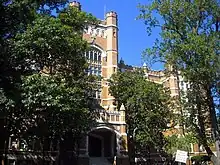
In 1975, the historic Freedman's Hospital closed after 112 years of use as Howard University College of Medicine's primary teaching hospital. Howard University Hospital opened that same year and continues to be used as HUCM's primary teaching hospital, with service to the surrounding community.
Also in 1975, Jeanne Sinkford became the first female dean of any American dental school when she was appointed as the dean of Howard University's school of dentistry.[26]
In 1989, Howard gained national attention when students rose up in protest against the appointment of then-Republican National Committee Chairman Lee Atwater as a new member of the university's board of trustees. Student activists disrupted Howard's 122nd-anniversary celebrations, and eventually occupied the university's administration building.[27] Within days, both Atwater and Howard's President, James E. Cheek, resigned.
21st century
In April 2007, the head of the faculty senate called for the ouster of Howard University President H. Patrick Swygert, saying the school was in a state of crisis, and it was time to end "an intolerable condition of incompetence and dysfunction at the highest level."[28] This came on the heels of several criticisms of Howard University and its management. The following month, Swygert announced he would retire in June 2008.[29] The university announced in May 2008 that Sidney Ribeau of Bowling Green State University would succeed Swygert as president.[30] Ribeau appointed a Presidential Commission on Academic Renewal to conduct a year-long self-evaluation that resulted in reducing or closing 20 out of 171 academic programs.[31] For example, they proposed closing the undergraduate philosophy major and African studies major.[31]

Six years later, in 2013, university insiders again alleged the university was in crisis. In April, the vice chairwoman of the university's board of trustees wrote a letter to her colleagues harshly criticizing the university's president and calling for a vote of no confidence; her letter was subsequently obtained by the media where it drew national headline.[32][33] Two months later, the university's Council of Deans alleged "fiscal mismanagement is doing irreparable harm," blaming the university's senior vice president for administration, chief financial officer and treasurer and asking for his dismissal.[34] In October, the faculty voted no confidence in the university's board of trustees executive committee, two weeks after university president Sidney A. Ribeau announced he would retire at the end of the year.[35] On October 1, the Board of Trustees named Wayne A. I. Frederick Interim President.[36] In July 2014 Howard's Board of Trustees named Frederick as the school's 17th president.[37]
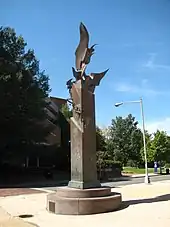
In May 2016, President Barack Obama delivered a commencement address at Howard University encouraging the graduates to become advocates for racial change and to prepare for future challenges.[38]
In 2018, nearly 1,000 students held a sit-in demanding injunction over the administration's use of funding, after a Medium post revealed that six university employees had been fired for "double dipping" financial aid and tuition remission. The university had discovered the fraud the previous year, but had not publicly disclosed the loss; 131 individuals were involved in some form, with the top 50 recipients accounting for 90% of the total, and the five most reimbursed individuals receiving $689,375 in refunds.[39][40] After the student protest ended, faculty voted "no confidence" in the university president, chief operating officer, provost, and board of trustees.[41] The nine-day protest ended with university officials promising to meet most of their demands.[42] It also led to an investigation by the Department of Education, which placed the university on "heightened cash monitoring", an increased form of scrutiny relating to the disbursement of student financial aid.[43] This monitoring status was rescinded in December of the following year.[44]
In July 2020, philanthropist MacKenzie Scott donated $40 million (~$41.7 million in 2021) to Howard. Her single donation is the largest in Howard's history and one of the largest ever to an HBCU.[45]
In May 2021, the university announced that the newly re-established college of fine arts, led by Dean Phylicia Rashad, would be named the Chadwick A. Boseman College of Fine Arts for the actor and distinguished alum who from his days as a student in the late 1990s through his death from cancer in 2020 led protests against the 1997 absorption of the College of Fine Arts into the College of Arts & Sciences.[46]
In October 2021, a group of students protested the mold, mice, and substandard conditions in campus residential buildings in the Blackburn Takeover, demanding an improvement in the living situation and representation on the board of trustees.[47][48] In 2023, Howard University issued a $300 million tax-exempt bond to tackle the housing woes.[49]
In March 2022, Howard University announced that it will spend $785 million over the next four years to construct new STEM complex, academic buildings to house the Chadwick Boseman School of Fine Arts, and the Cathy Hughes School of Communications, as well as renovate other buildings on campus.[50][51]
In 2023, Howard University was selected by the Department of the Air Force to lead a research center on tactical autonomy technology for military systems.[52]
Campus

The 256-acre (1.04 km2; 0.400 sq mi) campus, often referred to as "The Mecca", is in northwest Washington, D. C.[53] Major improvements, additions and changes occurred at the school in the aftermath of World War I. New buildings were built under the direction of architect Albert Cassell.[54][53]
Howard University has several historic landmarks on campus, such as Andrew Rankin Memorial Chapel, Frederick Douglass Memorial Hall, and the Founders Library.
The Howard University Gallery of Art was established by Howard's board of trustees in 1928. The gallery's permanent collection has grown to over 4,000 works of art and continues to serve as an academic resource for the Howard community.[55]

Howard University has eight residence halls for students: Drew Hall (male freshmen), College Hall North (female freshmen), The Harriet Tubman Quadrangle - "Quad" (female freshmen), Cook Hall (male freshmen), Bethune Annex (co-ed, continuing students), Plaza Towers West (co-ed, continuing students), College Hall South (co-ed, continuing students), The Axis (co-ed, continuing students), Mazza Grandmarc (co-ed, continuing students), WISH-Woodley Park (co-ed, continuing students) and Plaza Towers East (co-ed, continuing students).
Howard University Hospital, opened in 1975 on the eastern end of campus, was built on the site of Griffith Stadium, in use from the 1890s to 1965 as home of the first, second and third incarnations of the MLB Senators, as well as the NFL's Washington Redskins, several college football teams (including Georgetown, GWU and Maryland) and part-time home of the Homestead Grays of the Negro National League.
Howard University is home to the commercial radio station WHUR-FM 96.3, also known as Howard University Radio. A student-run station, WHBC, operates on an HD Radio sub-channel of WHUR-FM. Howard is also home to the public television station WHUT-TV, located on campus next to WHUR-FM.
Organization
The university is led by a board of trustees that includes a faculty trustee from the undergraduate colleges, a faculty trustee from the graduate and professional colleges serving three-year terms, two student trustees, each serving one-year terms, and three alumni-elected trustees, each serving three-year terms.[53]
Academics
| Academic rankings | |
|---|---|
| National | |
| ARWU[56] | 191–206 |
| Forbes[57] | 349 |
| THE / WSJ[58] | 127 |
| U.S. News & World Report[59] | 115 |
| Washington Monthly[60] | 141 |
| Global | |
| ARWU[61] | 901–1000 |
| QS[62] | 581–590 |
| THE[63] | 201–250 |
| U.S. News & World Report[64] | 761 |
Schools and colleges
- College of Engineering and Architecture
- College of Nursing & Allied Health Sciences
- College of Pharmacy
- College of Arts and Sciences
- Chadwick Boseman College of Fine Arts
- Howard University College of Dentistry
- Howard University School of Business
- Cathy Hughes School of Communications
- Howard University College of Medicine
- Howard University School of Law
- Middle School of Mathematics and Science
- School of Divinity
- School of Education
- School of Social Work
Faculty
Howard faculty include member of Congress from Maryland Roscoe Bartlett, blood banking pioneer Charles Drew,[65] Emmy-winning actor Al Freeman Jr.,[66] suffragist Elizabeth Piper Ensley,[67] civil rights lawyer Charles Hamilton Houston, media entrepreneur Cathy Hughes, marine biologist Ernest Everett Just, professor of surgery LaSalle D. Leffall Jr., journalists Nikole Hannah-Jones and Ta-Nehisi Coates,[68] political consultant Ron Walters, political activist Stacey Abrams, novelist and diplomat E. R. Braithwaite,[69] filmmaker Haile Gerima, and psychiatrist Frances Cress Welsing.
Honors programs
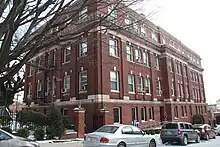
Howard offers four selective honors programs for its most high-achieving undergraduate students: the College of Arts & Sciences Honors Program, the School of Education Honors Program, the Executive Leadership Honors Program in the School of Business, and the Annenberg Honors Program in the School of Communications.[70]
Martha and Bruce Karsh STEM Scholars Program
In 2017, Howard established the Bison STEM Scholars Program to increase the number of underrepresented minorities with high-level research careers in science, engineering, technology, and mathematics. Bison STEM Scholars are given full scholarships and committed to earning a PhD or a combined MD–PhD in a STEM discipline. The highly competitive program annually accepts approximately 30 undergraduate students for each new cohort.[71][72] As of 2020, the Bison STEM Scholars Program was renamed the Martha and Bruce Karsh Stem Scholars Program (KSSP) following the $10 million (~$10.4 million in 2021) donation from the family's foundation.[73]
Google's Tech Exchange
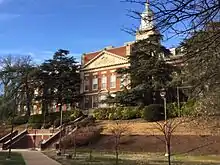
In 2017, Google Inc. announced it established a pilot residency program named "Howard University West" on its campus in Mountain View, California, to help increase underrepresented minorities in the tech industry. In 2018, the program expanded from a three-month summer program to a full academic year program and the name changed to "Tech Exchange" to be inclusive of 15 other minority-serving institutions added to the program such as Florida A&M, Prairie View A&M, and Fisk.[74] Howard students in the program learn from senior Google engineers, practice the latest coding techniques, and experience tech culture in Mountain View for course credits towards their degrees.[75][76]
Disney Storyteller Fund
In July 2022, the Walt Disney Company announced it established the Disney Storytellers Fund at the Cathy Hughes School of Communications and the Chadwick A. Boseman College of Fine Arts to support creative student projects. The fund provides undergraduate students with stipends up to $60,000 and mentorship intended to help cultivate a new generation of Black storytellers.[77] In October 2022, the fund expanded to other HBCU campuses.[78]
Michael Jordan Partnership
In 2022, Howard University signed a 20-year partnership with Nike's Michael Jordan Brand starting in 2022.
Research
Interdisciplinary Research Building
Howard's most prominent research building is the Interdisciplinary Research Building (IRB). Opened in 2016, the multi-story, 81,670 square foot, state-of-the-art research facility was completed for $70 million (~$78.4 million in 2021). The IRB was designed to promote more collaborative and innovative research on campus.[79]
Moorland-Spingarn Research Center
"The Moorland-Spingarn Research Center (MSRC) is recognized as one of the world's largest and most comprehensive repositories for the documentation of the history and culture of people of African descent in Africa, the Americas, and other parts of the world. The MSRC collects, preserves, and makes available for research a wide range of resources chronicling black experiences."[80]
NASA University Research Center (BCCSO)

The Beltsville Center for Climate System Observation (BCCSO) is a NASA University Research Center at the Beltsville, Maryland campus of Howard University. BCCSO consists of a multidisciplinary group of Howard faculty in partnership with NASA Goddard Space Flight Center Earth Sciences Division, other academic institutions, and government. This group is led by three Principal Investigators, Everette Joseph, also the director of BCCSO, Demetrius Venable and Belay Demoz. BCCSO trains science and academic leaders to understand atmospheric processes through atmospheric observing systems and analytical methods.[81][82]
Publications
Howard University is home to The Hilltop, the university's student newspaper. Founded in 1924 by Zora Neale Hurston, The Hilltop enjoys a long legacy at the university.
Howard University is the publisher of The Journal of Negro Education, which began publication in 1932. The Howard University Bison Yearbook is created, edited and published during the school year to provide students a year-in-review. Howard University also publishes the Capstone, the official e-newsletter for the university; and the Howard Magazine, the official magazine for the university, which is published three times a year.
Howard University Libraries
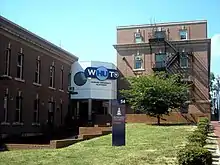
Howard University Libraries (HUL) is the library system of Howard University and is composed by eight branches and centers:
- The Founders Library, the main library, founded in January 1939.[83][84][85]
- The School of Business Library
- The School of Divinity Library
- The School of Social Work Library
- The Moorland-Spingarn Research Center
- The Channing Pollock Theatre Collection
- The Patent and Trademark Resource Center
- The Undergraduate Library (UGL).[86]
- Afro-American Studies Center[87]
Student life
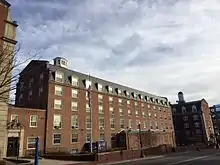
Athletics
Most of Howard's 21 NCAA Division I varsity teams compete in the Mid-Eastern Athletic Conference (MEAC).
Students
The U.S. students come from the following regions: New England 2%, Mid-West 8%, South 22%, Mid-Atlantic 55%, and West 12%.[53] Nearly 4% of the student body are international students. Howard University is 86% African-American/Black.[88]
Howard is one of the five largest HBCUs in the nation with around 10,000 students.[89] The student-to-faculty ratio is 7:1.[90]

Howard is a selective institution.[91] The incoming freshman class of fall 2021 had 29,391 applicants and 10,362 (35%) were accepted into Howard.[92]
There are over 200 student organizations and special interest groups established on campus.[93]
Howard produced four Rhodes Scholars between 1986 and 2017.[94] Between 1998 and 2009, Howard University produced a Marshall Scholar, two Truman Scholars, twenty-two Fulbright Scholars and ten Pickering Fellows.[95]
In 2020, 82% of first-year students received need-based financial aid.[96]
Greek letter organizations
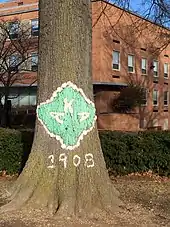
Howard University has many academic and social Greek letter organizations on campus. Howard is the founding site of the National Pan-Hellenic Council (NPHC) and five of the nine NPHC organizations. [97] Also, Howard is one of four HBCUs with a chapter of Phi Beta Kappa which is the oldest academic honor society in the U.S.[98][99]
Howard Homecoming
.jpg.webp)
Howard Homecoming week is the most prominent and richest cultural tradition of the institution.[100][101] Over 100,000 of alumni, students, celebrity guests, and visitors are in attendance to patronize the many events and attractions affiliated with the festive week on and near campus. While the specific calendar of events changes from year to year, the traditional homecoming events include the Homecoming Football Game and Tailgate, Pep Rally, Coronation Ball, Greek Step-Show (Howard NPHC Greeks), and Fashion Show. After a two-year hiatus, the Yardfest returned in 2016 as one of the cherished traditions.[102][103][104]
Howard's first official homecoming was held in 1924 and it takes place every fall semester with a new theme developed by the homecoming committee.[105][106]
Springfest
Springfest is an annual tradition created by the Undergraduate Student Association (UGSA) to celebrate the arrival of spring. Springfest is similar to homecoming week in the fall but on a smaller scale and with more emphasis on the student body. Springfest events traditionally include the Fashion Show, Talent Show, Vendor Fair, Poetry Showcase, Beauty Conference, Charity Basketball Game, and a major community service event. The schedule of events changes slightly each year.[107][108]
Bison Ball
The Bison Ball and Excellence Awards is an annual black tie gala hosted by the Howard University Student Association (HUSA). A select number of students, faculty, organizations, and administrators from the Howard community are honored for their exceptional accomplishments. This event takes place near the end of every spring semester.[109][110]
Resfest
Resfest week is a Howard tradition that involves freshmen living in residence halls on campus competing in several organized competitions (field day,[111] academic debate, dance, stroll,[112] step-show, etc.) for campus bragging rights. This event takes place on campus near the end of every spring semester.[113]
Notable alumni
Distinguished alumni of Howard University include the current (as of 2023) Vice President of the United States, several United States diplomats and United States governors, a United States Ambassador to the United Nations, foreign royals, seven foreign heads of state, 11 members of United States Congress, a Supreme Court Justice, directors and executives of Fortune 500 companies, Academy Award– and Emmy Award–winning actors, Grammy Award—winning songwriters and producers, two US Army generals, a US Air Force general and Vice Chief of Staff of the United States Air Force, and Nobel laureates including Nobel Prize for Literature winner Toni Morrison. Additional alumni include civil rights activists and pioneers in the Civil Rights Movement, a United States Secretary of Health and Human Services, a United States Secretary of Housing and Urban Development, a United States Secretary of Agriculture, 12 Mayors of American cities, and three State Attorneys General. Howard University has also produced many firsts, including Roger Arliner Young who became the first African-American woman to receive a doctorate in zoology, Benjamin O. Davis Sr. the first African-American US Army general, Johnson O. Akinleye, 12th Chancellor of North Carolina Central University, Thurgood Marshall, the first African-American Supreme Court justice, and Edward W. Brooke III who became the first African-American elected to the US Senate, among others. Howard University also counts four Rhodes Scholarship winners,[94] 22 Pickering Fellows, 11 Truman Scholars, over 70 Fulbright Scholars, a Schwarzman Scholar, a Goldwater Scholar, and two Pulitzer Prize winners and numerous other Pulitzer Prize nominees among its alumni. To date Howard University has granted over 120,000 degrees[114][95] and produces the most black doctorate recipients of any university.[115][116]
- Notable Howard University alumni include:
.jpg.webp)
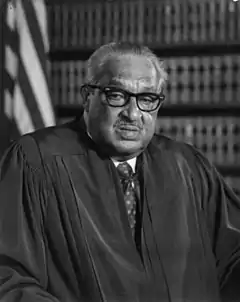
.jpg.webp)

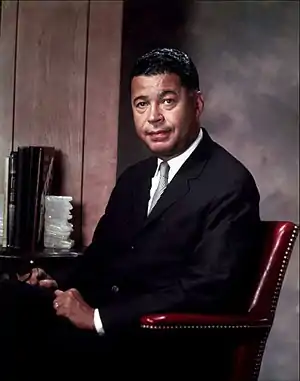
.jpg.webp)

 Ras Baraka, mayor of Newark, New Jersey
Ras Baraka, mayor of Newark, New Jersey
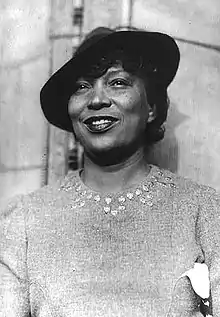 Zora Neale Hurston, author and anthropologist
Zora Neale Hurston, author and anthropologist Paul Laurence Dunbar, novelist and poet
Paul Laurence Dunbar, novelist and poet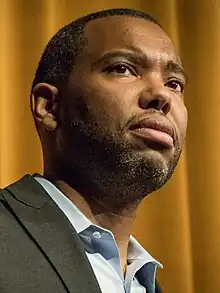 Ta-Nehisi Coates, writer and journalist
Ta-Nehisi Coates, writer and journalist Chadwick Boseman, actor
Chadwick Boseman, actor.jpg.webp) Phylicia Rashad, actress
Phylicia Rashad, actress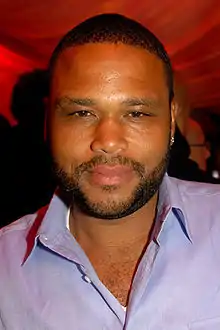 Anthony Anderson, actor
Anthony Anderson, actor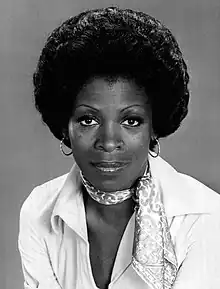 Roxie Roker, actress
Roxie Roker, actress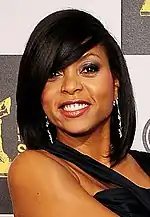 Taraji P. Henson, actress
Taraji P. Henson, actress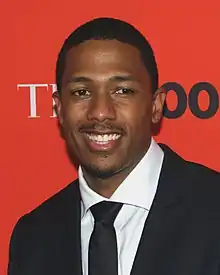 Nick Cannon, comedian, rapper and television host
Nick Cannon, comedian, rapper and television host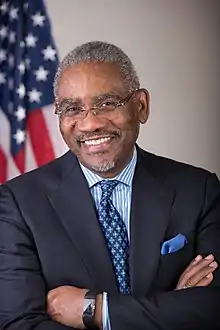
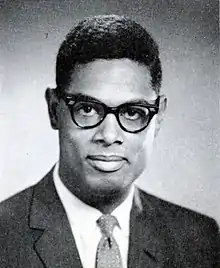 Thomas Sowell, economist, author and social commentator (attended)
Thomas Sowell, economist, author and social commentator (attended)
See also
- A Bridge Across and Beyond by artist Richard Hunt (a sculpture at the Blackburn Fountain)
- Howard Theatre
- List of presidents of Howard University
References
- "Howard University Celebrates Unprecedented Progress Powered by Howard Forward Strategic Plan".
- Ofori, Oral (July 11, 2017). "Howard University Partners with Google to raise percentage of black computer scientist and engineers".
- "Fall 2017-Fall 2021 Students Enrollment Trends". Howard University.
- "IPEDS College Navigator - Howard University". nces.ed.gov.
- "Web Style Guidelines". Howard University OUC.
- Howard University - Howard University and Lowe To Develop Mixed-Use Building Near University Campus
- "Carnegie Classifications Institution Lookup". carnegieclassifications.iu.edu. Center for Postsecondary Education. Retrieved September 12, 2020.
- "Brief History of Howard University". Howard.edu. Archived from the original on January 17, 2015. Retrieved October 19, 2009.
{{cite web}}: CS1 maint: unfit URL (link) - "The Semi-Centennial of Howard University". Howard University Record. 10 (2). March 1916.
- "U.S. Department of Education funding of Howard University". April 22, 2014.
- "February 7, 1994". Library of Congress Information Bulletin.
- "Little Known Black History Fact: Howard University". Black America Web. December 18, 2013. Retrieved March 15, 2019.
- Muse, Clifford L. (1991). "Howard University and the Federal Government During the Presidential Administrations of Herbert Hoover and Franklin D. Roosevelt, 1928-1945". The Journal of Negro History. 76 (1/4): 1–20. doi:10.1086/JNHv76n1-4p1. JSTOR 2717406. S2CID 149933299.
- Warren, Wini (1999). Black Women Scientists in the United States. Indiana University Press. p. 35. ISBN 9780253336033.
- "Segregated Student Housing and the Activists Who Defeated It". umn.edu. University of Minnesota. 2017. Retrieved July 11, 2020.
- "Loading..." www.africawithin.com.
- "The Nobel Peace Prize 1950". NobelPrize.org.
- "April 1943 Pauli Murray organizes Howard student sit-ins". SNCC Digital Gateway.
- Murray, Pauli (November 1944). "A Blueprint for First Class Citizenship". The Crisis. reprinted in Carson, Clayborne; Garrow, David J.; Kovach, Bill (2003). Reporting Civil Rights: American journalism, 1941–1963. Library of America. pp. 62–67. ISBN 9781931082280. Retrieved September 13, 2011.
- "TriniView.com - Stokely Carmichael or Kwame Ture". www.trinicenter.com.
- "Rayford W. Logan (1897–1982)". blackpast.org. January 21, 2007. Retrieved February 11, 2017.
- "Information on Edward Franklin Frazier". Archived from the original on September 28, 2007.
- "Calvin Coolidge: Address at Howard University: "The Progress of a People"". www.presidency.ucsb.edu. Retrieved November 27, 2017.
- "Commencement Address at Howard University: "To Fulfill These Rights", June 4, 1965". LBJ Presidential Library. Archived from the original on October 26, 2019.
- Johnson, Lyndon B. "To Fulfill These Rights". What So Proudly We Hail. Archived from the original on November 8, 2018. Retrieved February 12, 2013.
- "June 2002 CDA Journal - Feature Article, Copyright 2002 Journal of the California Dental Association". Cda.org. Archived from the original on September 28, 2011. Retrieved August 4, 2012.
- Stanley, Alessandra; Jacob V. Lamar (March 20, 1989). "Saying No to Lee Atwater". Time.com. Time Warner. Archived from the original on November 6, 2007.
- Susan Kinzie; Keith L. Alexander (March 10, 2007). "Ouster Sought of Howard President". The Washington Post. Retrieved February 13, 2010.
- "Howard University". The Washington Post. May 21, 2007. Retrieved February 13, 2010.
- Strauss, Valerie (May 8, 2008). "Bowling Green President Named to Top Position". The Washington Post. Retrieved February 13, 2010.
- de Vise, Daniel (December 14, 2010). "Howard prepares for test of its future". The Washington Post. p. B1.
- Jack Stripling (June 7, 2013). "In Ominous Letter, a Trustee Blasts Howard U.'s President and Board Chair". The Chronicle of Higher Education. Retrieved July 2, 2013.
- Nick Anderson (June 7, 2013). "Howard trustee says university in 'trouble'". The Washington Post. Archived from the original on October 20, 2013. Retrieved July 2, 2013.
- Nick Anderson (July 1, 2013). "Howard academic deans allege 'fiscal mismanagement'". The Washington Post. Retrieved July 2, 2013.
- Nick Anderson (October 16, 2013). "Howard faculty group votes no confidence in key Board of Trustees committee". The Washington Post. Retrieved October 18, 2013.
- "Howard University Press Release". Howard University. October 1, 2013. Archived from the original on November 15, 2013. Retrieved November 15, 2013.
- Emma Brown; Wesley Robinson (July 22, 2014). "Wayne A.I. Frederick named 17th president of Howard University". The Washington Post. Retrieved July 23, 2013.
- Rhodan, Maya (May 7, 2016). "President Obama Strikes Hopeful Tone in Howard University Commencement Speech". Time. Retrieved March 12, 2019.
- Kiely, Liv; Brocchetto, Marilia (March 29, 2018). "Howard University students demand answers in financial aid scandal". CNN. Retrieved April 14, 2023.
- Harriot, Michael (April 10, 2018). "Report Details How Employees Scammed Howard University for Hundreds of Thousands of Dollars". The Root. Retrieved April 14, 2023.
- Larimer, Sarah (April 12, 2018). "No confidence: Howard faculty members say in vote they have lost faith in school's leaders". The Washington Post. Retrieved May 27, 2018.
- Romo, Vanessa (April 6, 2018). "9-Day Student Protest At Howard University Ends With A Deal". The Two-Way. NPR.
- Kreighbaum, Andrew (August 30, 2018). "Feds Impose Aid Restrictions on Howard". Inside Higher Ed. Retrieved April 14, 2023.
- Howard Newsroom Staff (December 17, 2019). "Howard University Restored to Advanced Payment Method by Department of Education". The Dig. Retrieved April 14, 2023.
- Lumpkin, Lauren (July 28, 2020). "Howard University announces largest single-donor gift, from philanthropist MacKenzie Scott". The Washington Post.
- Jackson, Angelique (May 26, 2021). "Howard University Names Newly Re-Established College of Fine Arts for Chadwick Boseman".
- "Howard University students stage sit-in over board representation, housing issues". wusa9.com. October 13, 2021.
- Hopkins, Paige (November 3, 2021). "Howard University students stage sit-in over board representation, housing issues". axios.com.
- York, Carrington (March 24, 2023). "Howard University Tackles Persistent Housing Woes With Bond Deal". Bloomberg News. Retrieved March 27, 2023.
- Lumpkin, Lauren (March 23, 2022). "Howard University announces historic $785 million investment in new buildings, renovations". Washington Post. Retrieved May 13, 2022.
- Whitford, Emma (April 1, 2022). "Howard to spend $785M on new construction, renovations". Inside Higher Ed. Retrieved May 13, 2022.
- "US Air Force selects Howard University for science research partnership". Air Force. July 31, 2017. Retrieved January 30, 2023.
- "Howard Facts 2009 (PDF)" (PDF). Archived from the original (PDF) on March 25, 2009. Retrieved September 10, 2009.
- Clifford L. Muse Jr. (1991). "Howard University and The Federal Government During The Presidential Administrations of Herbert Hoover and Franklin D. Roosevelt, 1928–1945". The Journal of Negro History. Association for the Study of African-American Life and History, Inc. 76 (1/4): 1–20. doi:10.1086/JNHv76n1-4p1. JSTOR 2717406. S2CID 149933299.
- "Howard's Gallery of Art Among Top 50 in the United States - Howard University". Retrieved June 29, 2016.
- "ShanghaiRanking's Academic Ranking of World Universities". Shanghai Ranking Consultancy. Retrieved September 13, 2022.
- "Forbes America's Top Colleges List 2023". Forbes. Retrieved September 22, 2023.
- "Wall Street Journal/Times Higher Education College Rankings 2022". The Wall Street Journal/Times Higher Education. Retrieved July 26, 2022.
- "2023-2024 Best National Universities". U.S. News & World Report. Retrieved September 22, 2023.
- "2022 National University Rankings". Washington Monthly. Retrieved September 13, 2022.
- "ShanghaiRanking's Academic Ranking of World Universities". Shanghai Ranking Consultancy. Retrieved February 25, 2023.
- "QS World University Rankings 2024: Top global universities". Quacquarelli Symonds. Retrieved June 27, 2023.
- "World University Rankings 2024". Times Higher Education. Retrieved September 27, 2023.
- "2022-23 Best Global Universities Rankings". U.S. News & World Report. Retrieved February 25, 2023.
- Starr, Douglas P. (2000). Blood: An Epic History of Medicine and Commerce. New York: Quill. pp. 111–117. ISBN 978-0-7515-3000-1.
- "Acting Legend Al Freeman Jr. Remembered at Howard University – Howard University News Room". Howard.edu. March 16, 2000. Archived from the original on November 19, 2015. Retrieved July 19, 2015.
- "Denver cemetery's data "very valuable" to state". The Denver Post. December 23, 2005. Retrieved October 24, 2015.
- Fadel, Leila (July 9, 2021). "Nikole Hannah-Jones And Ta-Nehisi Coates To Join Howard University Faculty". NPR. Retrieved August 22, 2022.
- "E. R. Braithwaite, Author of 'To Sir, With Love', Dies at 104". The New York Times. December 13, 2016.
- "Honors Programs | Howard University - Undergraduate Studies". ous.howard.edu.
- "About | Karsh STEM Scholars". karshstemscholars.howard.edu. Retrieved January 30, 2020.
- "New Heights in STEM | Howard Magazine". magazine.howard.edu. Retrieved January 30, 2020.
- "Howard Receives $10 Million Donation, Largest in School History". January 30, 2020. Retrieved February 8, 2020.
- "Howard University and Google Expand Successful Computer Science Residency To Include Additional HBCUs". Howard Newsroom. September 19, 2018. Retrieved September 3, 2019.
- "Google opens Howard University West to train black coders". USA Today. Retrieved December 31, 2017.
- "Newsroom". Retrieved February 4, 2018.
- Childs, Kelvin (July 5, 2022). "Disney Storytellers Fund to Provide Stipends for Creative Student Projects". The Dig. Retrieved July 19, 2022.
- Daps, Mr (October 28, 2022). "The Walt Disney Company Announces A $1 Million Multi-Year Grant For Disney Storytellers Fund At Florida A&M University". Daps Magic. Retrieved November 2, 2022.
- "Howard University opens $70 million laboratory building, with hopes for more to come". The Washington Post. Retrieved June 29, 2016.
- "Howard History". Archived from the original on November 6, 2007.
- "About". Howard University Beltsville Center for Climate System Observation. Archived from the original on March 28, 2012. Retrieved August 2, 2011.
- "Beltsville Center for Climate System Observation (BCCSO)". Archived from the original on July 25, 2011. Retrieved August 10, 2011.
- "Howard University's Founders Library named a national treasure". The Washington Post.
- Cornish, Stephanie (March 2, 2016). "Howard University Library Named National Treasure - Afro".
- Willis, Kiersten (April 1, 2016). "Howard University Library Named National Treasure, to Be Modernized with New Technology".
- Matthews, Lopez. "LibGuides V2: Welcome to the Howard University Libraries: Contact Us". Archived from the original on June 6, 2017. Retrieved September 11, 2018.
- Matthews, Lopez. "LibGuides V2: Welcome to the Howard University Libraries: Contact Us". Archived from the original on June 6, 2017. Retrieved September 11, 2018.
- "Howard University (HU, HU) Introduction and Academics - Washington, DC". www.stateuniversity.com.
- "Largest HBCU in the Nation: Top 10 Black Colleges by Enrollment". August 25, 2018.
- "Howard University". U.S. News & World Report. Retrieved February 14, 2022.
- "Howard University". U.S. News & World Report. Retrieved February 11, 2017.
- "Admission Profile | Admission". admission.howard.edu.
- "Home | Howard University". .howard.edu. Archived from the original on April 2, 2016. Retrieved April 2, 2016.
- "Newsroom". Howard Newsroom.
- "Newsroom". Howard Newsroom. Retrieved March 13, 2019.
- https://www.usnews.com/best-colleges/howard-university-1448/paying
- "Campus Virtual Tour: Greek Organizations at Howard University". www.howard.edu.
- https://www.pbk.org/Chapter-Associations/ChapterDirectory
- https://www.diverseeducation.com/institutions/hbcus/article/15078761/working-toward-a-common-goal
- Ladipo, Bianca; Wagner, Andre (November 15, 2019). "At Howard University, Homecoming Is a Pilgrimage". The New York Times.
- II, C. Isaiah Smalls (October 22, 2017). "For the best HBCU homecoming, it's Spelhouse vs. Howard".
- "Howard's homecoming: a brand and a business". The Washington Post. Retrieved June 29, 2016.
- "Howard University Homecoming Event Lineup". Archived from the original on September 26, 2017. Retrieved May 20, 2017.
- "Hollywood Goes to Howard University Homecoming". November 3, 2010. Retrieved June 29, 2016.
- "Howard Homecoming 2011: The People, History, And Events". Retrieved May 20, 2017.
- "Howard Homecoming Committee Introduces 2016 Theme: Blueprint". July 13, 2016. Retrieved May 20, 2017.
- "The Hilltop, March 23, 2017, Volume 101, Issue 23". March 23, 2017. Retrieved December 31, 2017.
- "Rapper Fabolous Hosts Howard University High End Fashion Show "No Limits" For Springfest - The Rapfest Presents". April 3, 2017. Retrieved December 31, 2017.
- "Upcoming Events – Bison Ball & Excellence 2016 Awards". WHUT Howard University Television. Archived from the original on June 5, 2016. Retrieved June 29, 2016.
- "Bison Ball + Excellence Awards – The Concrete Rose". Archived from the original on June 1, 2016. Retrieved June 29, 2016.
- "field day". Wiktionary. Archived from the original on November 2, 2007.
- Thomas, Jackson (June 6, 2015). "What is strolling?". All About Strolling. Archived from the original on December 15, 2019.
- "Campus Virtual Tour: Residence Life at Howard University". Howard.edu. Retrieved April 2, 2016.
- "About Howard | Howard University". www2.howard.edu.
- "TECH-Levers: HBCUs Produce the Most Black Alums Who Receive Doctorates in Science and Engineering". Hbcu-levers.blogspot.com. Retrieved April 2, 2016.
- "History – Howard University". .howard.edu. Retrieved April 2, 2016.
Further reading
- Cain, Timothy Reese. " 'Only Organized Effort Will Find the Way Out!': Faculty Unionization at Howard University, 1918–1950." in Higher Education for African Americans Before the Civil Rights Era, 1900-1964 (Routledge, 2017) pp. 119-156.
- Dodson, Howard. "HOWARD UNIVERSITY, THE NEW NEGRO MOVEMENT, AND THE MAKING OF AFRICAN AMERICAN VISUAL ARTS IN WASHINGTON, DC." Callaloo 39.5 (2016): 983-998. online
- Dyson, Walter. The Founding of Howard University (Howard University Press, 1921) online.
- Epps, Howard R. "The Howard University Medical Department in the Flexner Era: 1910-1929." Journal of the National Medical Association 81.8 (1989): 885+ oline
- Green, Rodney D., and Aisha Thompson. "Streams of racial progress: The discipline of economics at Howard University at its sesquicentennial." Negro Educational Review 68.1-4 (2017): 31-157. online
- Henry, Charles P. "Abram Harris, E. Franklin Frazier, and Ralph Bunche: The Howard School of Thought on the Problem of Race." in The Changing Racial Regime (1995): 36+. online
- Hopkins, Reginald, Sherman Ross, and Leslie H. Hicks. "A history of the Department of Psychology at Howard University." Journal of the Washington Academy of Sciences (1992): 161-167. online
- Hunter, Gregory. " Howard University: 'Capstone of Negro education' during World War II." Journal of Negro History 79.1 (1994): 54-70. online
- LaPoint, Velma, and Veronica Thomas. "Contributions of Howard University to social science research on Black children." Monographs of the Society for Research in Child Development (2006): 173-187. online
- Lindsey, Treva. "Climbing the Hilltop: In Search of a New Negro Womanhood at Howard University." in Escape from New York: The New Negro Renaissance beyond Harlem (2013): 271-290. online
- Logan, Rayford W. Howard University: The first hundred years, 1867-1967 (NYU Press, 1969) online, a standard scholarly history.
- McFeely, William S. Yankee Stepfather: General O.O. Howard and the Freedmen (Yale University Press, 1968) online
- Matthews, Lopez D. Howard University in the World Wars: Men and Women Serving the Nation (Arcadia Publishing, 2019) online.
- Muse, Clifford L. "Howard University and the Federal Government During the Presidential Administrations of Herbert Hoover and Franklin D. Roosevelt, 1928-1945". Journal of Negro History (1991) 76 (1/4): 1–20. online
- Myers, Joshua M. We Are Worth Fighting For: A History of the Howard University Student Protest of 1989 (New York University Press. 2019) online
- Perkins, Linda M. "Black undergraduate women’s experiences of race, gender, and class at Fisk and Howard universities and Tuskegee institute, 1923–1960." in Critical perspectives on Black women and college success (Routledge, 2017) pp. 31-44. online
- Perkins, Linda M. "Merze Tate and the Quest for Gender Equity at Howard University: 1942–1977." History of Education Quarterly 54.4 (2014): 516-551. online
- Poulson, Stephen C. Racism on Campus: A Visual History of Prominent Virginia Colleges and Howard University (Routledge, 2021) online
- Rasheed, Lisa R. "Lucy Diggs Slowe, Howard University Dean of Women, 1922-1937: Educator administrator, activist" (Thesis, Georgia State University, 2010) online.
- Ray, Louis. "Competing Visions of Higher Education: The College of Liberal Arts Faculty and the Administration of Howard University, 1939–1960." in Higher Education for African Americans before the Civil Rights Era, 1900-1964 (Routledge, 2017) pp. 157-178. online
- Relerford, Jimisha. "Campus Protest and Composition Pedagogy: G. David Houston's Activist Rhetoric at Howard University." Spectrum: A Journal on Black Men 9.1 (2021): 21-36. excerpt
- Thomas, Jennifer C. "Pageantry & Politics: Miss Howard University from Civil Rights to Black Power." Journal of Negro Education 87.1 (2018): 22-32. excerpt
- Zaluda, Scott. "Lost voices of the Harlem renaissance: Writing assigned at Howard University, 1919-31." College Composition and Communication 50.2 (1998): 232-257. online
.jpg.webp)

